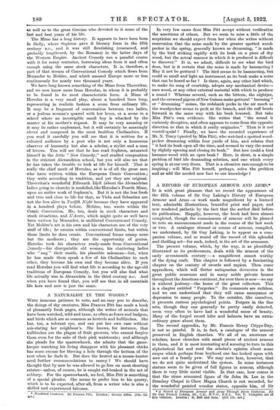A NATURALIST IN THE WOODS.* Wrra immense patience to note,
and an easy pen to describe, the doings of shy creatures, Miss Frances Pitt has made a book of pleasantly fresh pages, although she writes of animals that have been watched, wild and tame, as often as foxes and badgers, and birds which are as common as kestrels and bullfinches. She has, too, a tolerant eye, and can put her own case without mis-stating her neighbour's. She knows, for instance, that bullfinches are the plague of fruit growers, who cannot forgive them even for the sake of their pink waistcoats ; and although she pleads for the sparrowhawk, she admits that the game- keeper watching his living disappear with his pheasant chicks has some excuse for blowing a hole through the bottom of the nest when he finds it. But does the kestrel as a mouse-hunter need further recommendations to mercy ? We should have thought that by now he was allowed to go free on most shooting estates—unless, of course, he is caught red-beaked in the act of robbery. For the sparrowhawk, we feel, Miss Pitt is something of a special pleader. She seems to prefer him to his quarry, which is to be expected, after all, from a writer who is also a skilled and experienced falconer.
* Woodland Creatures. By Frances Pitt. London: George Allen. [12e. Od. net.] In very few cases does Miss Pitt accept without verification the assertions of others. But we seem to miss a little of the scepticism we should expect from her when she writes without reservation that the noise made by the greater spotted wood. pecker in the spring, generally known as drumming, "is made by the bird striking rapidly with its beak on a piece of dry wood, but the actual manner in which it is produced is difficult to discover." It is, we admit, difficult to see what the bird does, but is it certain that the noise is made by hammering ? May it not be guttural ? The bird seems to be hammering, but could so small and light an instrument as its beak make a noise that can be heard so far ? Is there, again, any other bird which, to make its song of courtship, adopts any mechanical device—, uses wood, or any other external material with which to produce a sound ? Whereas several, such as the bittern, the nightjar, and the crowned pigeon of New Guinea make guttural " booming" or " drumming " noises, the redshank pecks in the air much as the woodpecker seems to peck at the branch, and the ruff bends forward in the same way with his beak lowered. But take Miss Pitt's own evidence. She writes that "the sound is curiously deceptive, and often appears to come from the opposite direction to that in which it really originates." Then is it not ventribquial ? Finally, we have the recorded experience of Mr. N. Tracy (quoted by Miss Pitt), who watched a spotted wood- pecker drumming within four yards of him, and relates that "it had its beak open all the time, and seemed to vary the sound by slightly opening and closing its beak." But how could a bird hammer wood with an open beak ? Here, in short, is a simple problem of bird life demanding solution, and one which every spring is at our very doors. That is a situation rare enough to be inspiring : will Miss Pitt herself, perhaps, solve the problem and so add the needed new fact to our knowledge ?


































 Previous page
Previous page